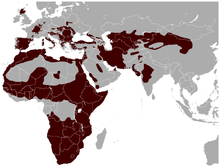WildCATS
| Wildcat | |
|---|---|
 |
|
| European wildcat (Felis silvestris silvestris) | |
| Scientific classification | |
| Kingdom: | Animalia |
| Phylum: | Chordata |
| Class: | Mammalia |
| Order: | Carnivora |
| Family: | Felidae |
| Subfamily: | Felinae |
| Genus: | Felis |
| Species: | F. silvestris |
| Binomial name | |
|
Felis silvestris Schreber, 1777 |
|
| Subspecies | |
|
See text |
|
 |
|
| Distribution of five Felis silvestris subspecies | |
 |
|
| Wildcat range | |
See text
The wildcat (Felis silvestris) is a small cat native to most of Africa, Europe, and Southwest and Central Asia into India, western China, and Mongolia. Because of its wide range it is assessed as Least Concern on the IUCN Red List since 2002. However, crossbreeding of wildcat and domestic cat (Felis silvestris catus) occurs in particular in Europe and is considered a potential threat for the preservation of the wild species.
The wildcat shows a high degree of geographic variation. Whereas the Asiatic wildcat is spotted, the African wildcat is faintly striped, has short sandy-grey fur, banded legs, red-backed ears and a tapering tail. The European wildcat is striped, has long fur and a bushy tail with a rounded tip, and is larger than a domestic cat.
The wildcat is the ancestor of the domestic cat. Genetic, morphological and archaeological evidence suggests that domestication of Old-World wildcats began approximately 7500 years BCE in the Fertile Crescent region of the Near East. The association of wildcats with humans appears to have developed along with the growth of agricultural villages during the Neolithic Revolution, with wildcats preying on rodents that infested the grain stores of early farmers.
...
Wikipedia

